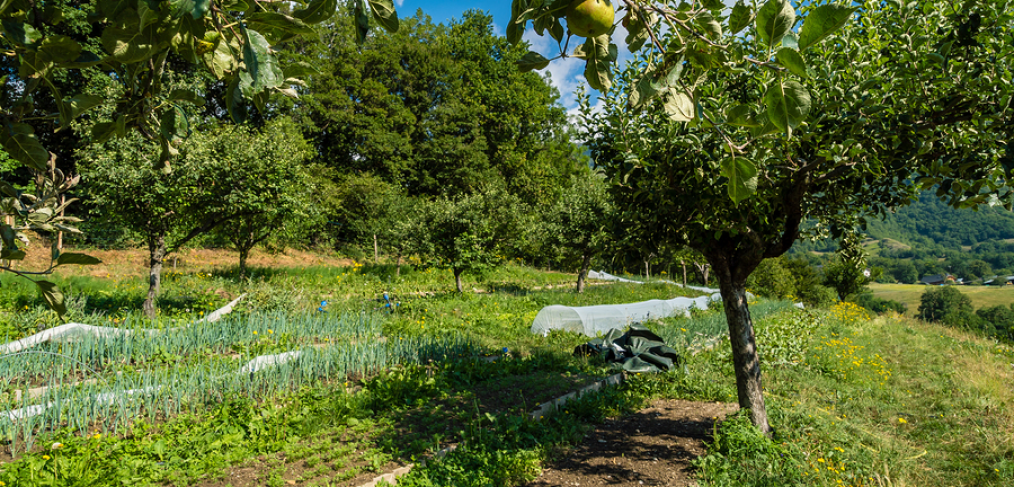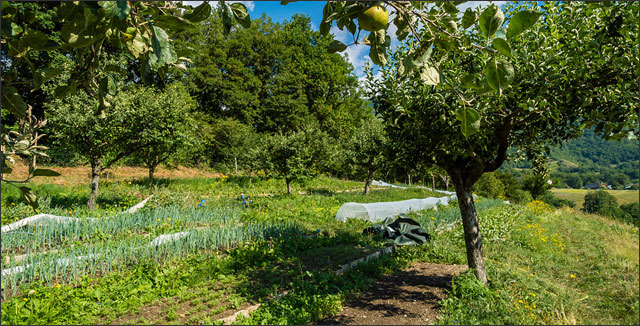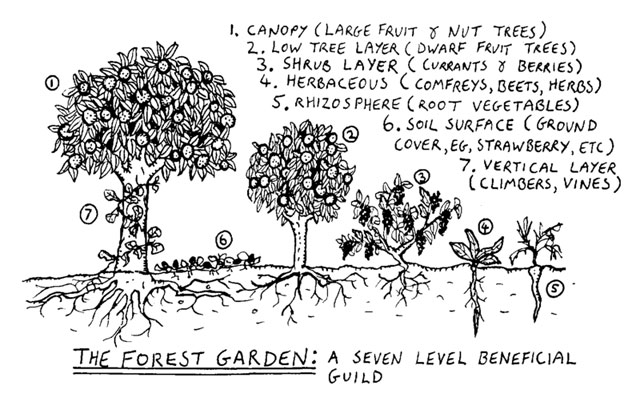
Food Forests: What Are They and How Do They Function?

Have you heard of food forests? Do you wonder what they are and how they work?
Since we’ve delved into the subject of permaculture and what it is, I thought it would nice to break it down a little further and to give readers a picture of how one particular aspect of a permaculture farm, or garden, can look.
More specifically, I want to talk about one of the terms I alluded to before: the “Food Forest.”
Terms like “food forest” are popping up on the internet along with other organic, green or sustainable topics. If you have done any reading about organic gardening, you’ve probably seen this term.
“Food Forest” certainly does conjure up images of foraging for nuts and edible fungus, if it doesn’t merely make you think of a fairy tale. However, the ideas behind creating a food forest – or a permaculture orchard – are exciting, and many of them have been in use for centuries.
Permaculture Zones
As mentioned in our previous post about permaculture, one of the ideas behind this practice involves a smart and sensitive use of design. Whereas the typical concept of farming necessitates large swathes of land for food and animal feed production, the ideas behind permaculture tend toward the utilization of all available space for both food production and foraging animals.
In many models of a permaculture farm design, you will find the layout broken up into 6 or 7 zones according to their function and the necessary amount of cultivation associated with each.
Not every piece of land is situated to allow for the heaviest use areas to be close to the house, but the zones typically radiate out from the center. Zone 0, which includes the house is where you’d also keep herbs and micro greens for daily use.
Zones 1 and 2 are then the areas requiring the most work: including most of your edible plants, greenhouse, orchards, and animals who need tending every day.
The food forest is designed to inhabit Zone 2. It’s not the most visited part of your permaculture design, but it does require massive cultivation and some maintenance once it is well-established.
Orchards From The Past
There so many wonderful layers to designing a permaculture farm – including which plants and trees grow well together and why.
One of the fascinating things about this idea is that it’s not new. Our ancestors might have called them orchards. However, the principles of permaculture were in use there before modern farming practices made them Monocultures dependent on pesticides and fertilizer.
For instance, it was a common practice in English orchards to first place goats on the land to clear it, and then chickens, ducks, and geese to add manure and manage soil-borne pests before planting orchards.
They would then plant a mixture of fruit and nut trees, always keeping honey bees in the orchard to improve pollination.
After an orchard was established and fruiting, pigs could be turned into it to eat the windfall fruit and thereby cut down on feed bills.
Isn’t that genius? Doesn’t that sound like common sense?

Food Forests Garden Diagram by Graham Burnett*
Seven Layers to a Food Forest
When you are going to cultivate your food forest, there are many classes you can take to help you understand the best way to use your available land.
Permaculture models are often scalable for your particular needs and restrictions. Thus, it’s possible to incorporate food production to almost any size yard you have, be it urban, suburban or rural.
In keeping with the concept of stacking functions, which means making your design serve multiple purposes at once, a food forest would be cultivated in 7 layers.
Here’s how that could look:
Tall Tree Layer
One of the first things you would want to establish would be your full-sized fruit and nut trees or fast-growing nitrogen-fixing trees.
Examples of this would be chestnut or walnut trees, nut-bearing pines, rootstock apple trees, and pear and plum trees.
Nitrogen fixing plants include carob, alder, mesquite, black locust, and tagasaste. Linden, silver birch or robe locust trees count as well. As in the title, these will be your tallest trees and most needful of full sunlight.
A word about nitrogen-fixing plants: they are one of nature’s miracles. Because these types of plants can’t absorb nitrogen from the air on their own, they grow with a symbiotic bacterium called Rhizobium.
Rhizobium attaches to the root system and uses the plant to draw nitrogen from the air. When the plant dies, it provides nitrogen back into the soil instead of depleting the soil of this precious mineral.
Low Tree Layer
Next, you would plant shade-tolerant, semi-dwarf fruit trees like what you would find in most orchards:
- Apples
- Pears
- Persimmon
- Apricot
- Peach
- Almond
- Nectarine
- Plum
- Cherry
Or you could plant coffee trees.
Shrub Layer
Here’s where your orchard starts to get interesting.
Unlike a monoculture orchard, you want to attract a full range of wildlife and pollinators and to create a habitat for foraging animals. You would, therefore, plant flowering shrubs and edibles including:
- Roses
- Serviceberry
- Hazel
- Filberts
- Willow
- Bamboo
- Butterfly bush
- Lilac
- Raspberry
- Currants
- Chokeberry
- Elder
- Sage
- Rosemary and many more!
If you have an idea of what some of these plants are, you can see the potential for diversity and usefulness on every layer of this plan.
Herb Layer
These plants include non-woody vegetation in the form of edible and medicinal herbs. Some of these plants accumulate nutrients and produce biomass for mulch:
- Sweet cicely
- Parsley
- Tarragon
- Fennel
- Dill
- Thyme
- Peppers
- Tomatoes
- Okra
- Sorrel
- Collards
- Chard
- Bush beans
- Echinacea
- Mint
- Chives
- Lemongrass and so many more.
Ground Cover
Now you’re starting to picture just how dense and diverse this forest is meant to be. You are not going to find big, open spaces of grass here; just an amazing jungle of harmony and biodiversity.
As a ground cover, you can plant many types of creeping plants such as strawberry, clover, chamomile, and thyme.
Vine Layer
Of course, you want to utilize your available climbing surfaces for plants. No tree-trunk should be left bare when it can be used.
Perennial vining flowers can thrive in this layer:
- Passionflower
- Kiwi
- Hops
- Grapes – or bee-attracting flowering vines like honeysuckle, trumpet flower, roses, and clematis.
Vining plants like beans, squash, cucumbers, and melons belong here as well.
Root Layer
The root layer would consist of:
- Radish
- Turnips
- Potatoes
- Turmeric
- Ginger
- Carrots
- Parsnips
- Garlic
- Onions
- Sweet potato
Other root vegetables and herbs belong here as well – rather than in a vast bed of bare earth.
Animals in the Mix
As you can see, this design allows for massive food production. It uses plants for mulch and fertilizer rather than relying on a yearly or twice-yearly tilling and application of fertilizer to bare ground.
In addition, as I mentioned at the beginning, this zone is also well-suited to house foraging animals.
In a permaculture farm, the goal is to stack functions and to make it self-sustaining.
Animals can provide three primary services to this zone:
- Pest control
- Fertilizer
- And meat production
If your area allows you to keep pigs, they can forage and eat windfall once your fruit trees have been established.
Chicken runs and fences can be incorporated into the design to allow chickens to eat both pests and windfall. Their manure is gardening gold.
Then, the eggs and meat you harvest from foraging animals are much healthier for you because of the biodiverse diet they’ve eaten and the exercise they’ve gotten.
Takeaway
Food forests are one aspect of permaculture design. However, they are arguably the most exciting and most important zone in the plan.
I hope you had fun reading about food forests and maybe it will inspire you to incorporate permaculture concepts into your own gardening!
*Photo Credit: Graham Burnett. www.appropedia.org/Forest_gardens



